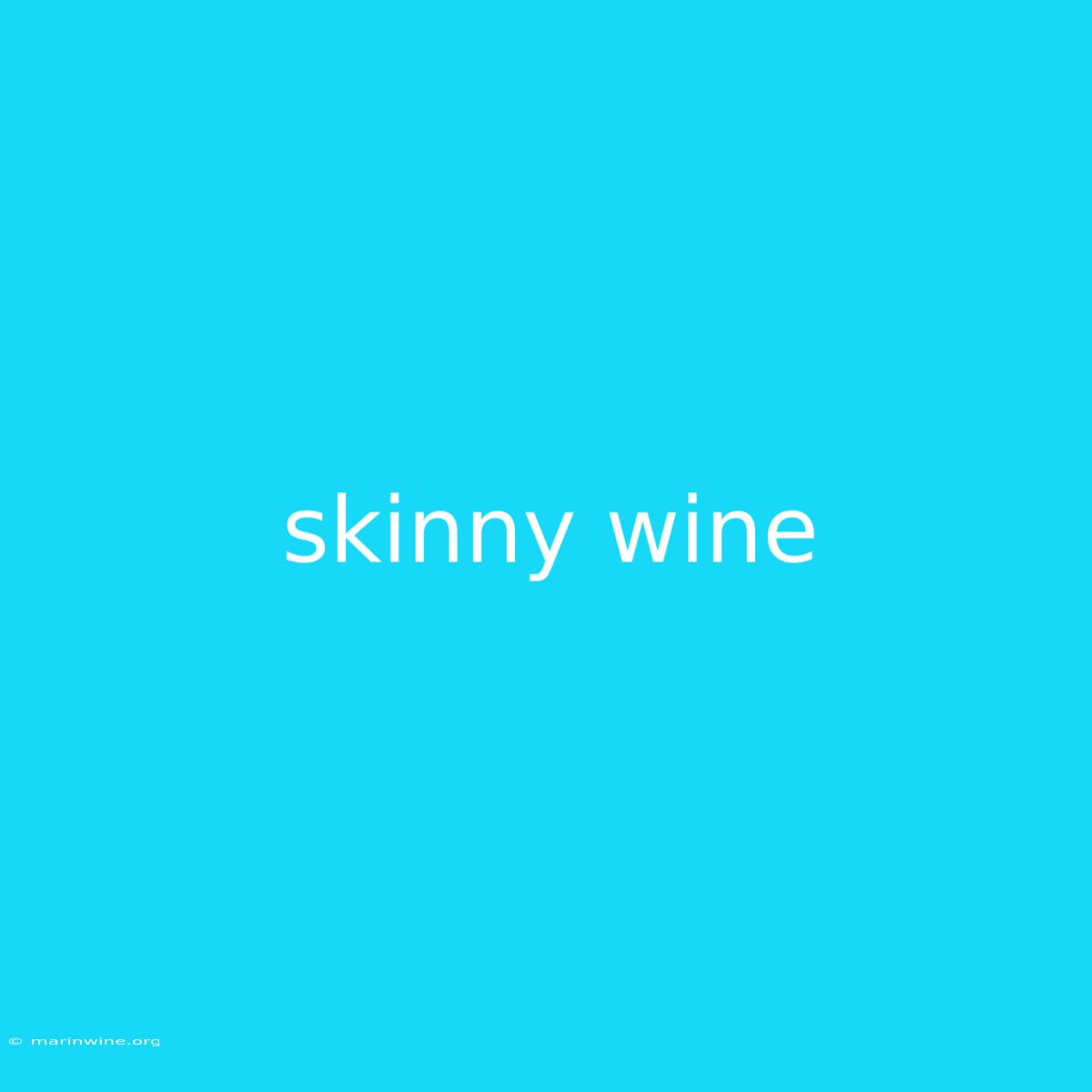Uncorking the Truth: Is Skinny Wine Really "Skinny"?
Is "skinny wine" all it's cracked up to be? The truth is, it's not a magic potion for weight loss.
Why This Matters
The popularity of "skinny wine" is on the rise, with many consumers lured by the promise of reduced calories and sugar. But does it actually deliver on its claims? This review dives into the science behind "skinny wine" to help you make informed decisions about your beverage choices. We'll explore the key factors that influence calorie content in wine and uncover the realities behind "skinny" labels.
Key Takeaways of Skinny Wine
| Feature | Skinny Wine | Regular Wine |
|---|---|---|
| Calories | Lower | Higher |
| Sugar Content | Lower | Higher |
| Taste | Can be more acidic or less complex | Varies widely depending on grape varietal and winemaking process |
| Health Effects | Similar to regular wine in moderation | Similar to regular wine in moderation |
| Price | Typically more expensive | Typically less expensive |
Skinny Wine
Introduction
The concept of "skinny wine" is appealing for many, promising a guilt-free way to enjoy a glass of wine. But the term itself is a bit of a marketing ploy, as there's no universally recognized definition or standard for what constitutes "skinny wine."
Key Aspects
- Reduced Calories: "Skinny wine" brands often achieve lower calorie counts by using techniques like:
- Lower Alcohol Content: Alcohol is calorie-dense, so wines with lower alcohol by volume (ABV) naturally have fewer calories.
- Sugar Reduction: Winemaking techniques can reduce the amount of residual sugar, further lowering the calorie count.
- Taste and Quality: The pursuit of lower calories can sometimes compromise the wine's flavor profile. Some "skinny wines" may be more acidic or lack the complexity of their full-bodied counterparts.
Point: Calorie Reduction
Introduction
Understanding how calorie reduction in "skinny wine" works is crucial. It's essential to remember that the calorie content of wine depends on various factors, including the grape varietal, winemaking process, and alcohol content.
Facets
- Alcohol Content: Alcohol contributes significantly to the calorie content of wine. Lower ABV wines have fewer calories. For instance, a 125 ml serving of a 14% ABV wine typically contains around 125 calories, while a 125 ml serving of a 9% ABV wine might contain around 80 calories.
- Sugar Reduction: Winemaking techniques like "dry farming" or "late harvest" influence the sugar content of grapes, which translates to the final wine's sugar level. "Skinny wines" often undergo further processes to remove residual sugar, further reducing calorie content.
- Artificial Sweeteners: Some "skinny wine" brands may utilize artificial sweeteners, which can potentially alter the flavor profile and raise concerns about their health impacts.
Summary
While "skinny wine" can offer lower calorie options, it's important to consider that the taste and quality might differ from traditional wines.
Information Table: Uncorking the Skinny
| Type of Wine | Typical Alcohol Content (ABV) | Average Calories per 125 ml Serving |
|---|---|---|
| Cabernet Sauvignon | 13.5-14.5% | 125-135 calories |
| Pinot Grigio | 11-12% | 100-110 calories |
| "Skinny" Cabernet Sauvignon | 9-10% | 80-90 calories |
| "Skinny" Pinot Grigio | 8-9% | 70-80 calories |
FAQ for Skinny Wine
Introduction
Here are some common questions about "skinny wine" and their answers.
Questions
Q: Is "skinny wine" healthier than regular wine?
A: "Skinny wine" doesn't inherently make it healthier than regular wine. Both types offer similar health benefits in moderation, but excessive consumption can lead to health risks.
Q: Is "skinny wine" better for weight loss?
A: "Skinny wine" can contribute to weight loss only if it replaces higher-calorie beverages or is consumed in moderation as part of a balanced diet and exercise plan. It's not a magic bullet for weight loss.
Q: Can I taste the difference between "skinny wine" and regular wine?
A: Some "skinny wines" may have a different taste profile than their regular counterparts, potentially being more acidic or less complex.
Summary
"Skinny wine" might be a good option for those seeking lower calories, but it's not a guaranteed weight loss solution. It's crucial to consider individual taste preferences and make informed choices based on your health goals.
Tips for Choosing Skinny Wine
Introduction
Here are some tips for navigating the world of "skinny wine":
Tips
- Read the Label: Look for the calorie and sugar content on the label to make an informed decision.
- Try Before You Buy: Sample a few "skinny wines" before committing to a bottle, as taste preferences can vary.
- Consider the Price: "Skinny wines" are often more expensive than their regular counterparts, so be prepared for that.
- Don't Forget Moderation: Even "skinny wine" should be consumed in moderation as part of a healthy lifestyle.
Summary
Choosing the right "skinny wine" comes down to your individual needs and preferences. Consider the calorie and sugar content, taste profile, and budget when making your decision.
Summary by Skinny Wine
This exploration of "skinny wine" reveals that while it may offer lower calorie options, it's not a guaranteed weight loss solution. The taste and quality can vary, and it's crucial to be informed about the techniques used to achieve calorie reduction. When considering "skinny wine," prioritize your health goals and make informed choices based on your individual needs and preferences.
Closing Message
As with any beverage, moderation is key. Remember, a healthy lifestyle involves a balanced diet, regular exercise, and mindful choices about what you consume. Enjoy a glass of wine responsibly, "skinny" or not!

